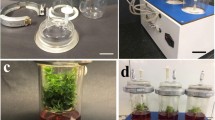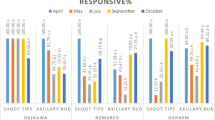Abstract
Limitations to large-scale propagation of purple pitahaya (Hylocereus costaricensis [F.A.C. Weber] Britton & Rose), a potential source of betalains for the food industry, can be overcome through utilization of in vitro culture technologies. In this work, successful in vitro propagation from areoles of adult purple pitahaya plants is reported. Factors affecting culture initiation, bud sprouting and growth, shoot multiplication, rooting, and acclimatization were studied. Best results for culture initiation were obtained from the central region of new joints by disinfection of large (5–7 cm in length) explants that were subsequently divided. Explants were sequentially treated with Extran® alkaline detergent for 10 min, followed by immersion in 70 % (v/v) ethanol for 15–30 s, a mixture of the fungicide Benomyl and the bactericide Agrymicin (2 g l−1 each) for 30 min, and disinfection in sodium hypochlorite (1.0 % w/v) for 15 min. Culture of sectioned individual areoles, without removing thorns, on Murashige and Skoog medium supplemented with 15 or 30 μM N 6-benzylaminopurine (BAP) for 3 mo with monthly subcultures, followed by transfer to the same medium with reduced BAP (0–2 μM), induced bud sprouting in over 80 % of explants, adequate growth of the shoots, with production of lateral shoots, and spontaneous rooting within 160 d. These plants were successfully acclimatized in vermiculite and peat moss (1:1), or perlite and peat moss (2:1) in the greenhouse, with over 90 % survival rate. One hundred percent of the in vitro-derived plants were successfully transferred to the field. Furthermore, these plants showed higher survival rates, larger height and increase in stem diameter than equivalent plants from the same genotype, derived from stem segments (the common clonal propagation system utilized for this species) that were simultaneously planted.



Similar content being viewed by others
References
Aliyu B, Mustapha Y (2007) Effect of different media on the in vitro growth of cactus (Opuntia ficus-indica) explants. Afr J Biotechnol 6:1330–1331
Brasil J, Jereissati E, Santos M, Campos F (2005) In vitro micropropagation of Nopalea cochenillifera (Cactaceae). J Appl Bot Food Qual 79:160–162
Brukhin V, Morozova N (2011) Plant growth and development—basic knowledge and current views. Math Model Nat Phen 6:1–53
Chandra S, Bandopadhyay R, Kumar V, Chandra R (2010) Acclimatization of tissue cultured plantlets: from laboratory to land. Biotechnol Lett 32:1199–1205
Dabekaussen MAA, Pierik RLM, Van der Laken JD, Hoek Spaans J (1991) Factors affecting areole activation in vitro in the cactus Sulcorebutia alba Rausch. Sci Hortic 46:283–294
de Medeiros LA, de Ribeiro RCS, Gallo LA, de Oliveira ET, Demattê MESP (2006) In vitro propagation of Notocactus magnificus. Plant Cell Tissue Organ Cult 84:165–169
Drew RA, Azimi M (2002) Micropropagation of red pitaya (Hylocereous undatus). Acta Horticult 575:93–98
El Obeidy AA (2006) Mass propagation of pitaya (dragon fruit). Fruits 61:313–319
Escobar AHA, Villalobos VM, Villegas AVM (1986) Opuntia micropropagation by axillary proliferation. Plant Cell Tissue Organ Cult 7:269–277
Esquivel P, Stintzing FC, Carle R (2007a) Comparison of morphological and chemical fruit traits from different pitaya genotypes (Hylocereus sp.) grown in Costa Rica. J Appl Bot Food Qual 81:7–14
Esquivel P, Stintzing FC, Carle R (2007b) Pigment pattern and expression of colour in fruits from different Hylocereus sp. genotypes. Innov Food Sci Emerg Technol 8:451–457
Estrada-Luna AA, JdJ M-H, Torres-Torres ME, Chablé-Moreno F (2008) In vitro micropropagation of the ornamental prickly pear cactus Opuntia lanigera Salm-Dyck and effects of sprayed GA3 after transplantation to ex vitro conditions. Sci Hortic 117:378–385
García-Saucedo PA, Valdez-Morales M, Valverde ME, Cruz-Hernández A, Paredes-López O (2005) Plant regeneration of three Opuntia genotypes used as human food. Plant Cell Tissue Organ Cult 80:215–219
Giusti P, Vitti D, Fiocchetti F, Colla G, Saccardo F, Tucci M (2002) In vitro propagation of three endangered cactus species. Sci Hortic 95:319–332
Heiskanen J (1995) Physical properties of two-component growth media based on Sphagnum peat and their implications for plant-available water and aeration. Plant Soil 172:45–54
Juárez MC, Passera CB (2002) In vitro propagation of Opuntia ellisiana Griff. and acclimatization to field conditions. Biocell (Mendoza) 26:319–324
Khalafalla M, Abdellatef E, Mohameed-Ahmed MM, Osman M (2007) Micropropagation of cactus (Opuntia ficus-indica) as strategic tool to combat desertification in arid and semi arid regions. Int J Sustain Crop Prod 2:1–8
Kluge M, Razanoelisoa B, Brulfert J (2001) Implications of genotypic diversity and phenotypic plasticity in the ecophysiological success of CAM plants, examined by studies on the vegetation of Madagascar. Plant Biol 3:214–222
Le Bellec F, Vaillant F, Imbert E (2006) Pitahaya (Hylocereus spp.): a new fruit crop, a market with a future. Fruits 61:237–250
Machakova I, Zazimalova E, George EF (2008) Plant Growth Regulators I: Introduction; Auxins, their Analogues and Inhibitors. In: George EF, Hall MA, De Klerk G-J (eds) Plant propagation by tissue culture, 3rd edn. Springer, Dordrecht, pp 175–204
Malda G, Backhaus RA, Martin C (1999a) Alterations in growth and crassulacean acid metabolism (CAM) activity of in vitro cultured cactus. Plant Cell Tissue Organ Cult 58:1–9
Malda G, Suzán H, Backhaus R (1999b) In vitro culture as a potential method for the conservation of endangered plants possessing crassulacean acid metabolism. Sci Hortic 81:71–87
Merten S (2003) A review of Hylocereus production in the United States. J Prof Assoc Cactus Dev 5:98–105
Mohamed-Yasseen Y (2002) Micropropagation of pitaya (Hylocereus undatus Britton et Rose). In Vitro Cell Dev Biol Plant 38:427–429
Morton J (1987) Strawberry pear. In: Morton J. F. (ed) Fruits of warm climates. Miami, FL, pp 347–348
Murashige T, Skoog F (1962) A revised medium for rapid growth and bio assays with tobacco tissue cultures. Physiol Plant 15:473–497
Orea CDP, Medrano VA (2007) Pitahaya (Hylocereus undatus) acclimatization: a pedagogical model. Acta Horticult 748:195–198
Pérez-Molphe-Balch E, Dávila-Figueroa CA (2002) In vitro propagation of Pelecyphora aselliformis Ehrenberg and P. strobiliformis Werdermann (Cactaceae). In Vitro Cell Dev Biol Plant 38:73–78
Quiala E, Matos J, Montalvo G, de Feria M, Chávez M, Capote A, Pérez N, Barbón R, Kowalski B (2009) In vitro propagation of Pilosocereus robinii (Lemaire) Byles et Rowley, endemic and endangered cactus. J Prof Assoc Cactus Dev 11:18–25
Ramirez-Malagon R, Aguilar-Ramirez I, Borodanenko A, Perez-Moreno L, Barrera-Guerra J, Nuñez-Palenius HG, Ochoa-Alejo N (2007) In vitro propagation of ten threatened species of Mammillaria (Cactaceae). In Vitro Cell Dev Biol Plant 43:660–665
Rubluo A, Chávez V, Martínez AP, Martínez-Vázquez O (1993) Strategies for the recovery of endangered orchids and cacti through in-vitro culture. Biol Conserv 63:163–169
Santos-Díaz MDS, Méndez-Ontiveros R, Arredondo-Gómez A, Santos-Díaz MDL (2003) In vitro organogenesis of Pelecyphora aselliformis Erhenberg (Cactaceae). In Vitro Cell Dev Biol Plant 39:480–484
Shen X, Kane ME, Chen J (2008) Effects of genotype, explant source, and plant growth regulators on indirect shoot organogenesis in Dieffenbachia cultivars. In Vitro Cell Dev Biol Plant 44:282–288
Shishkova S, García-Mendoza E, Castillo-Díaz V, Moreno NE, Arellano J, Dubrovsky JG (2007) Regeneration of roots from callus reveals stability of the developmental program for determinate root growth in Sonoran Desert Cactaceae. Plant Cell Rep 26:547–557
Skirvin RM, Motoike S, Norton MA, Ozgur M, Al-Juboory K, McMeans OM (1999) Establishment of contaminant-free perennial plants in vitro. In Vitro Cell Dev Biol Plant 35:278–280
Sriskandarajah S, Serek M (2004) Regeneration from phylloclade explants and callus cultures of Schlumbergera and Rhipsalidopsis. Plant Cell Tissue Organ Cult 78:75–81
Stintzing FC, Carle R (2007) Betalains - emerging prospects for food scientists. Trends Food Sci Technol 18:514–525
Wyka TP, Hamerska M, Wroblewska M (2006) Organogenesis of vegetative shoots from in vitro cultured flower buds of Mammillaria albicoma (Cactaceae). Plant Cell Tissue Organ Cult 87:27–32
Acknowledgments
This investigation was partially funded by the University of Costa Rica (project number VI-734-A5-029). Authors wish to thank R. Crespo, F. Brenes-Alvarez, and E. Arias-Bustos for kindly providing the starting plant material used in this work. Moreover, we are grateful to D. González from the National Technical University in Costa Rica for providing facilities for field experiments. Assistance of A. Murillo-Williams, A. Monge and E. Rodríguez during field work is also acknowledged. Authors specially wish to thank journal editor for the critical reading of the manuscript, very valuable comments and improvements.
Author information
Authors and Affiliations
Corresponding author
Additional information
Editor: John W. Forster
Rights and permissions
About this article
Cite this article
Viñas, M., Fernández-Brenes, M., Azofeifa, A. et al. In vitro propagation of purple pitahaya (Hylocereus costaricensis [F.A.C. Weber] Britton & Rose) cv. Cebra. In Vitro Cell.Dev.Biol.-Plant 48, 469–477 (2012). https://doi.org/10.1007/s11627-012-9439-y
Received:
Accepted:
Published:
Issue Date:
DOI: https://doi.org/10.1007/s11627-012-9439-y




